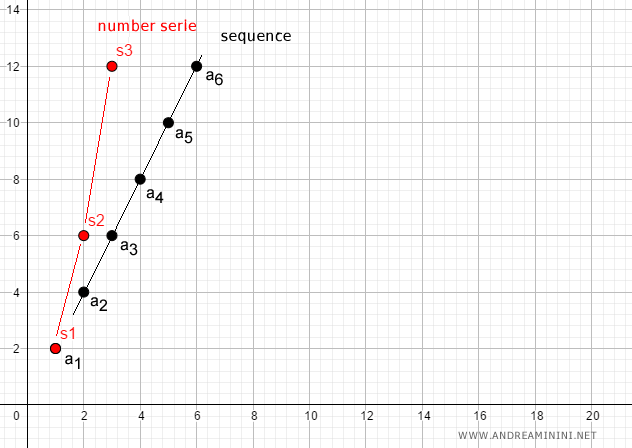Number Series
A number series sn is the sum of the first n terms of a given sequence an. It's also referred to as the n-th partial sum. $$ s_n = a_1+a_2+...+a_n $$ or, more compactly: $$ s_n = \sum_{k=1}^n a_k $$
The partial sum sk represents a general term ak of the number series.
If a sequence contains n terms, then the series will have n corresponding partial sums, one for each k = 1...n.
$$ s_1, s_2, ... , s_n $$
Note. The sequence sn of partial sums, as n approaches infinity (n→∞), defines the number series associated with the original sequence.
An Example of a Series
Consider the sequence an:
$$ a_n = 2n $$
The first n terms of the sequence an are:
$$ 2, 4, 6, 8, 10, ... $$
The corresponding partial sums of the series sn are:
$$ s_1 = 2 $$
$$ s_2 = 2+4 = 6 $$
$$ s_3 = 2+4+6 = 12 $$
$$ s_4 = 2+4+6+8 = 20 $$
$$ s_5 = 2+4+6+8+10 = 30 $$
So the number series sn of partial sums becomes:
$$ s_1, s_2, s_3, s_4, s_5, ... , s_n $$
$$ 2, 6, 12, 20, 30, ... , s_n $$
The graph below shows the number series (in red) plotted on a Cartesian plane.

What’s the difference between a series and a sequence? A sequence is an ordered list of individual terms ak. A series, on the other hand, is the sequence of partial sums sk formed by summing the terms of a sequence. For instance, the third term of the sequence is a3 = 6. The third partial sum of the series is s3 = a1 + a2 + a3 = 2 + 4 + 6 = 12.
Infinite Series
A series is called an infinite series when n = ∞.
$$ \sum_{k=1}^∞ a_k $$
An infinite series is defined as the limit of the partial sums sn as n approaches infinity:
$$ \lim_{n \rightarrow ∞} s_n $$
Why is the limit of the series important?
The limit determines the convergence behavior of the series - whether it converges, diverges, or is indeterminate.
Note. A series is considered regular if it either converges or diverges. If it does neither, it's known as an irregular series.
Convergence of a Series
The nature (or behavior) of a number series refers to whether the series converges, diverges, or lacks a well-defined limit.
- Convergent series. A series converges if the limit of the partial sums exists and is a finite number. In this case, the sequence sn tends to a finite value S as n→∞, called the sum of the series: $$ \lim_{n \rightarrow ∞} s_n = S $$
Note. The sum of the series equals the infinite sum of the terms of the sequence an: $$ S = \sum_{k=1}^∞ a_n $$
- Divergent series. A series diverges if the limit of the partial sums tends to positive or negative infinity: $$ \lim_{n \rightarrow ∞} s_n = ±∞ $$
- Indeterminate. A series is indeterminate if the limit does not exist. This is the case for irregular series.
And so on.
- Number Series
- Convergent Series
- Divergent Series
- Regular Series
- Irregular Series
- Operations with Series (sum and scalar multiplication)
- Remainder of a Series
- Theorem on Series with Non-Negative Terms
- Geometric Series
- Harmonic Series
- Generalized Harmonic Series
- Comparison Test for Series
- Vanishing Term Theorem (Test for Divergence)
- Ratio Test
- Root Test
- Integral Test
- Alternating Series
- Absolutely Convergent Series
- Taylor Series
- Fourier Series
Exercises
- The Series of Natural Numbers and Gauss’s Formula
- Mercator Series (Mengoli's Series)
